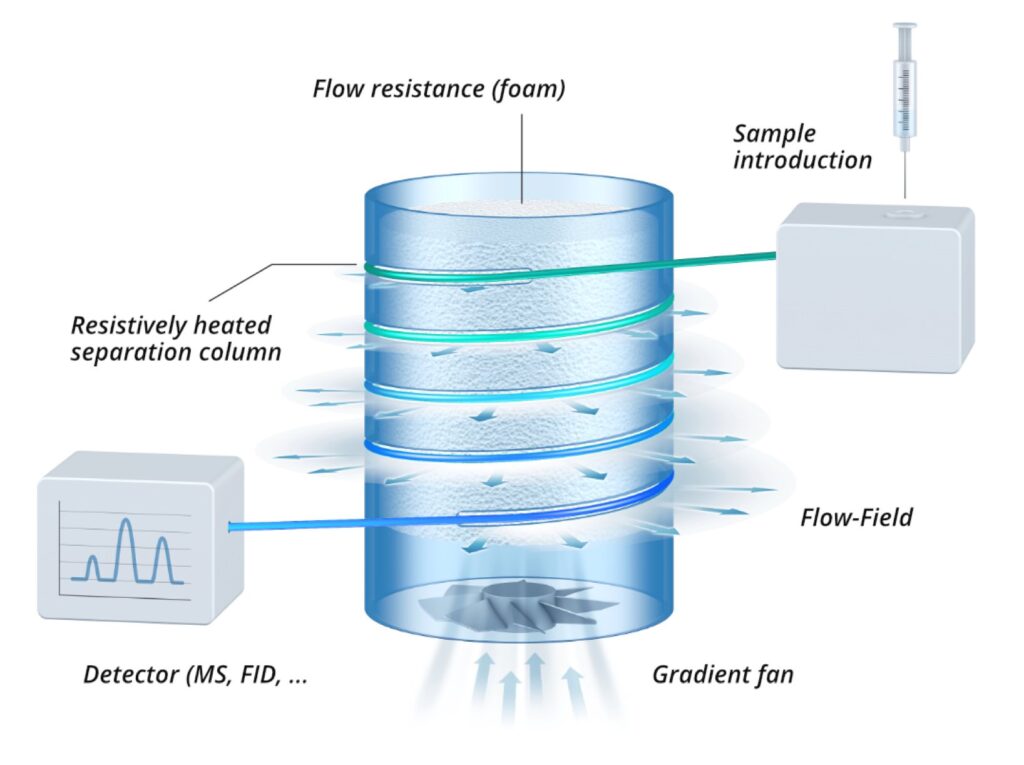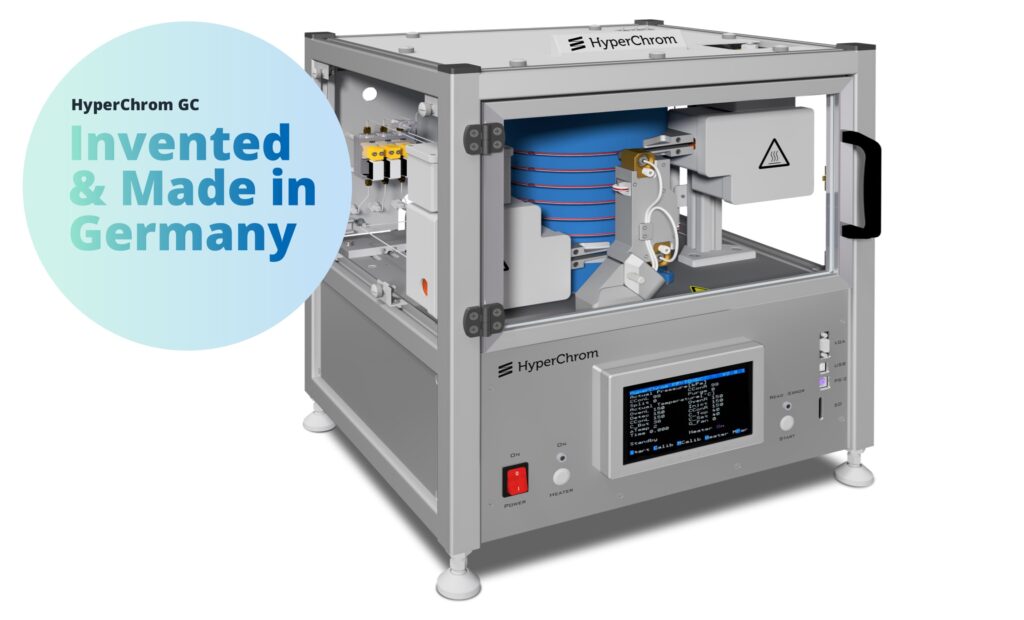GC can be used for various applications, such as environmental analysis, petrochemicals, food and beverages, pharmaceuticals, etc. However, conventional GC systems have some limitations, such as long analysis time, low resolution, and poor stability.
The HyperChrom GC is a new and innovative product that revolutionises gas chromatography with its speed, resolution, and stability. It uses a spatial thermal gradient and an integrated liquid cooling system to achieve high performance and efficiency.
It also has a user-friendly interface and a modular design that allows for easy customisation and maintenance. In this article, we will explain how the product works and what are its unique features, and compare it with conventional GC systems.
How HyperChrom GC Works
HyperChrom GC is based on the principle of spatial thermal gradient (STG), which is a novel concept that creates a temperature gradient along the length of the column. The STG allows for faster heating and cooling of the column, which reduces the analysis time and improves the resolution. The STG also eliminates the need for oven cycling, which increases the stability and reduces the energy consumption.
The STG is achieved by using an integrated liquid cooling system that circulates coolant through microchannels embedded in the column holder. The coolant temperature is controlled by a thermoelectric cooler (TEC), which can switch between heating and cooling modes in milliseconds. The TEC also monitors the column temperature and adjusts the coolant flow accordingly.

The column holder is made of aluminium alloy, which has high thermal conductivity and low thermal expansion. The column holder can accommodate up to four columns of different lengths and diameters, which can be easily installed and replaced. The column holder also has electrical connectors for connecting the detectors and injection units.
The detectors and injection units are modular and compatible with various types of columns and analytes. The detectors include flame ionisation detector (FID), thermal conductivity detector (TCD), electron capture detector (ECD), photoionisation detector (PID), mass spectrometer (MS), etc. The injection units include split/splitless injector, programmed temperature vaporiser (PTV), on-column injector, etc.
The user interface of HyperChrom GC is simple and intuitive, which allows for easy operation and configuration of the system. The user interface consists of a touchscreen display, a keyboard, and a mouse. The user can access various functions and settings of the system, such as method development, data acquisition, data analysis, system diagnostics, etc.
How HyperChrom GC Compares with Conventional GC Systems
HyperChrom GC has several advantages over conventional GC systems, which can be summarised as follows:
- Speed: HyperChrom GC can reduce the analysis time by up to 90%, compared to conventional GC systems. This is because HyperChrom GC can heat and cool the column faster than oven cycling, which reduces the run time and the equilibration time. For example, HyperChrom GC can perform a complete analysis of benzene, toluene, ethylbenzene, and xylene (BTEX) in less than 2 minutes, while conventional GC systems may take up to 20 minutes.
- Resolution: HyperChrom GC can improve the resolution by up to 50%, compared to conventional GC systems. This is because HyperChrom GC can create a sharper temperature gradient along the column, which enhances the separation efficiency and reduces the peak broadening. For example, HyperChrom GC can separate 16 polycyclic aromatic hydrocarbons (PAHs) in less than 4 minutes, while conventional GC systems may take up to 10 minutes.
- Stability: HyperChrom GC can increase the stability by up to 100%, compared to conventional GC systems. This is because HyperChrom GC eliminates the need for oven cycling, which reduces the thermal stress and wear on the column and other components. For example, HyperChrom GC can maintain a consistent retention time for more than 1000 injections, while conventional GC systems may show significant drift after 100 injections.
In addition to these advantages, HyperChrom GC also has other benefits, such as:
- Energy saving: HyperChrom GC can reduce the energy consumption by up to 80%, compared to conventional GC systems. This is because HyperChrom GC uses liquid cooling instead of air cooling, which reduces the heat loss and the power requirement. For example, HyperChrom GC consumes only 150 W of power, while conventional GC systems may consume up to 800 W of power.
- Space saving: HyperChrom GC has a compact design that occupies less space than conventional GC systems. This is because HyperChrom GC integrates the column holder, the cooling system, and the user interface in a single unit, which reduces the size and weight of the system. For example, HyperChrom GC has dimensions of 40 x 40 x 40 cm and a weight of 20 kg, while conventional GC systems may have dimensions of 60 x 60 x 60 cm and a weight of 40 kg.
- Cost saving: HyperChrom GC can reduce the cost of ownership by up to 50%, compared to conventional GC systems. This is because HyperChrom GC requires less maintenance and consumables, such as columns, detectors, injection units, etc. For example, HyperChrom GC can use a single column for multiple applications, while conventional GC systems may need to change the column for different applications.

Conclusion
HyperChrom GC is a new and innovative product that revolutionises gas chromatography with its speed, resolution, and stability.
It uses a spatial thermal gradient and an integrated liquid cooling system to achieve high performance and efficiency. It also has a user-friendly interface and a modular design that allows for easy customisation and maintenance.
HyperChrom GC has several advantages over conventional GC systems, such as energy saving, space-saving, and cost saving. HyperChrom GC can be used for various applications and industries, such as environmental analysis, petrochemicals, food and beverages, pharmaceuticals, etc.
If you are interested in learning more about HyperChrom GC or ordering one for your laboratory, please contact us. We will be happy to assist you with any questions or enquiries you may have.

